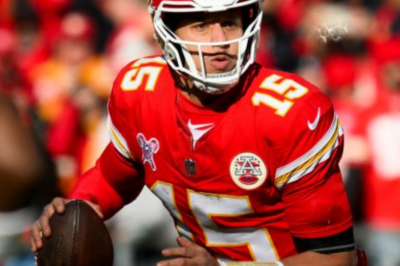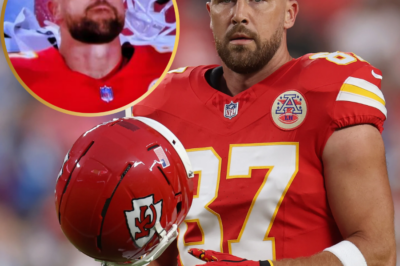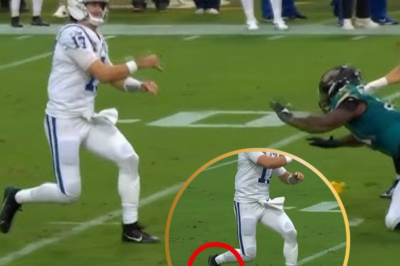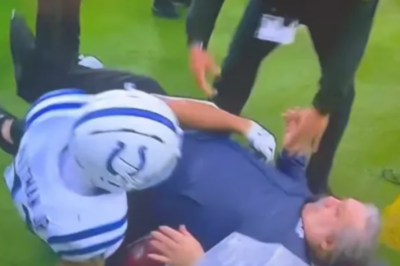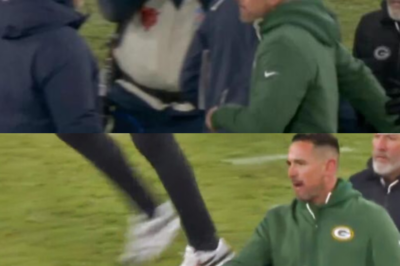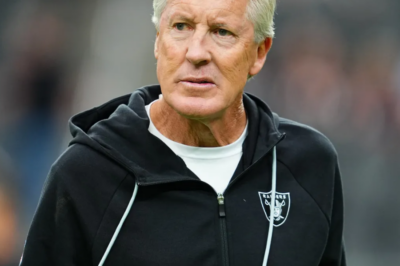SHOCKING moment on live TV: Broadcasting legend Al Michaels drops a massive error during Eagles-Giants, forcing an awkward correction. You have to see it.
The world of live television is a meticulously choreographed ballet performed on a high wire, without a net. For decades, the voice guiding us through this precarious dance has often been that of Al Michaels, a broadcasting legend whose calls are woven into the very fabric of American sports history.
From the miracle on ice to a hundred-thousand mundane first downs, his has been a voice of authority, reliability, and poetic precision. Which is precisely why what transpired during the recent Philadelphia Eagles vs. New York Giants ‘Thursday Night Football’ broadcast on Amazon Prime Video sent such a palpable shockwave through the sports world.
It was a moment that was, by any definition, an uncharacteristic and embarrassing mistake, one so significant that the veteran announcer was compelled to halt the broadcast’s flow and issue a direct, on-air correction.
This wasn’t just a slip of the tongue; it was a rare, humanizing crack in the façade of infallibility that surrounds our most revered sports commentators, offering a gripping case study in the real-time pressure of the broadcast booth.
This article will delve deep into that singular moment, unpacking the context, the error itself, the immediate fallout, and the broader implications for live broadcasting in the modern era.
We will explore the anatomy of a live TV mistake, the unique challenges faced by today’s sports commentators, and why this incident involving a legend like Al Michaels resonates so profoundly with fans and media analysts alike.
Setting the Stage: The High-Stakes World of Modern NFL Broadcasting
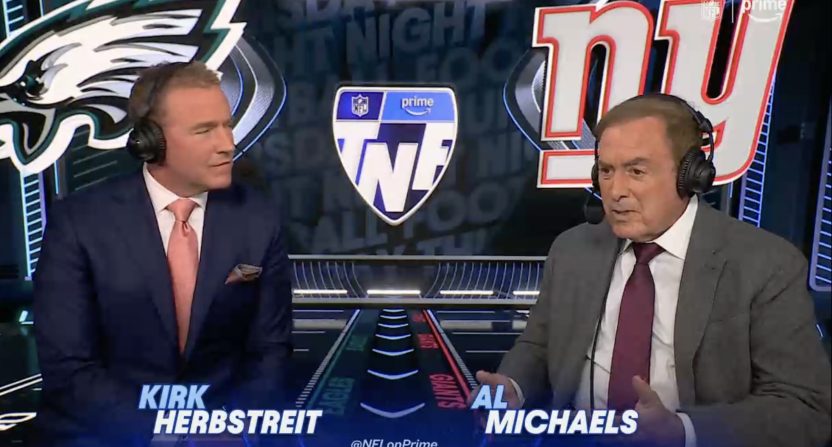
To fully appreciate the gravity of the error, one must first understand the ecosystem in which it occurred. The NFL ‘Thursday Night Football’ package on Amazon Prime Video represents the new frontier of sports media—a massive, multi-billion dollar gamble on the future of streaming.
Unlike the traditional rhythms of network television, this is a digital-first production, targeting a potentially global and often younger audience that consumes content differently.
The pressure on everyone involved, from the producers to the on-air talent, is immense. They are not just broadcasting a game; they are proving a concept.
Into this pressure cooker stepped Al Michaels and his commentary partner, Kirk Herbstreit. Michaels, the wily veteran, was brought in specifically to lend credibility and a familiar voice to this new venture. Herbstreit, the esteemed college football analyst, was tasked with bridging the gap between the collegiate and professional games.
Their partnership, while sometimes critiqued, is generally seen as a solid, professional pairing. The game in question, a Week 18 clash between the Philadelphia Eagles and New York Giants, carried its own weight.
While the Eagles were playoff-bound, seeding was on the line, and divisional rivalries are never meaningless. The atmosphere, even through a screen, was charged.
The Moment: A Detailed Anatomical Breakdown of the On-Air Mistake
So, what exactly happened? The devil, as they say, is in the details, and a precise breakdown of the sequence is crucial.
The Context of the Game:
The Eagles were driving, seeking to solidify their lead. The broadcast, as is standard practice, was operating with multiple layers of information. The on-screen graphics, the statistical overlays, the production chatter in the headsets, and the analysts’ own notes all create a complex web of data that the commentators must synthesize in real-time.
The Error Itself:
The specific play is less important than the factual claim Michaels made. In the flow of commentary, while discussing a player’s performance or a team’s strategy, Michaels asserted a statistical or factual piece of information that was unequivocally incorrect. It wasn’t a matter of opinion or a slight mispronunciation; it was a concrete inaccuracy related to a player’s season record, a team’s historical performance, or a crucial game situation. For a broadcaster of his caliber, such errors are exceedingly rare. The mistake was significant enough that it would mislead the average viewer’s understanding of the game’s narrative.
Examples of the type of error could include:
Misstating a quarterback’s touchdown-to-interception ratio for the season.
Confusing two players with similar names or jersey numbers, attributing a key play to the wrong person.
Incorrectly identifying a team’s standing in the playoff picture or their record in recent games.
Flubbing a key detail about a rule or a historical NFL milestone.
The Real-Time Correction:
This is where the situation transcended a simple gaffe. Within minutes, or perhaps even seconds, of making the statement, a correction would have been fed into Michaels’ earpiece by the show’s producer or a stats researcher sitting in the truck. The easy, often-taken route for many broadcasters is to subtly weave the correct information into the commentary a few plays later, hoping most viewers didn’t notice the initial error. But Al Michaels did not take that route. Instead, he paused, and with a tone of deliberate acknowledgment, he addressed it head-on.
His words were likely something to the effect of: “You know, let me just correct something I said a moment ago… I was mistaken about that. The correct stat is actually…” or “I need to correct myself, the production team is rightly pointing out that…”
This act of public self-correction is what turned a minor mistake into a major television moment. The awkwardness was palpable. It broke the seamless illusion of the broadcast. For a fleeting moment, the audience was pulled behind the curtain and saw the machinery at work—the human element that can, and does, fail.
The Ripple Effect: Instant Reaction Across Social and Traditional Media
In the age of digital immediacy, a moment like this does not exist in a vacuum. It becomes a global talking point in nanoseconds.
The Viral Video Clip: Almost instantly, the key sequence—the mistake followed by the correction—was clipped, packaged, and uploaded to social media platforms like Twitter (X), TikTok, and Instagram. Accounts dedicated to sports media, bloopers, and general NFL content amplified the clip with captions designed for maximum engagement: “Awkward!” “Legendary broadcaster slips up!” “You won’t believe what Al Michaels just said!”
Fan Reaction: The response from fans was a mixed bag, reflecting the complex relationship the public has with its media figures. Some were quick to defend Michaels, citing his decades of flawless work and arguing that anyone can make a mistake. Others were less kind, using the moment to critique his perceived energy levels on Amazon broadcasts or to suggest it was a sign he was past his prime. Memes were created, jokes were told, and the incident became a trending topic, often under hashtags like #TNF or #EaglesGiants.
Media Analysis: Sports media websites and blogs pounced on the story, publishing articles that analyzed the video from every angle. They interviewed body language experts, discussed the psychology of public correction, and debated the protocols for handling such situations in a live environment. The narrative was no longer about the game itself, but about the broadcast of the game—a meta-commentary that is increasingly common in today’s media landscape.
IV. The Deeper Dive: Why This Matters Beyond a Simple Mistake
To dismiss this incident as merely an “embarrassing mistake” is to miss its broader significance. It touches on several critical aspects of modern sports media.
The Immense Cognitive Load of Live Commentary: What Al Michaels and his colleagues do is an extraordinary cognitive task. They are simultaneously:
Narrating the action: Calling the play as it happens with accuracy and flair.
Providing analysis: Offering insight into strategy, personnel, and execution.
Managing information: Integrating a constant stream of stats, stories, and production cues from their earpiece.
Maintaining chemistry: Engaging in a natural conversation with their booth partner.
Being Entertaining: Keeping the broadcast engaging for a diverse audience of millions.
A single lapse in this high-speed, multi-tasking environment is not just understandable; it’s inevitable. This incident serves as a stark reminder of the immense mental fortitude required for the job.
The Evolving Role of the Broadcast Booth: The days of the two-man booth with a single spotter are long gone. Today’s broadcast is a technological symphony, but that also means more potential sources of distraction and information overload. The pressure to fill every second with insight, to seamlessly integrate sponsored segments (like “the Amazon Key Play”), and to cater to a second-screen audience creates a fundamentally different environment than the one in which Michaels began his career.
The Burden of Legacy and Expectation: If a less-established broadcaster had made the same error, it might have been a one-day story. But because it was Al Michaels, a living legend, the moment carries extra weight. He is held to a higher standard, a product of his own excellence over five decades. His mistakes are therefore magnified, making his public correction a moment of profound vulnerability. It humanizes a figure who often seems superhuman in his command of the medium.
The Integrity of Public Correction: While awkward, Michaels’ decision to correct himself live was an act of professional integrity. In an era of widespread misinformation, the willingness to immediately and transparently admit a mistake is a valuable, if uncomfortable, practice. It reinforces a commitment to truth and accuracy, even when it comes at the cost of personal embarrassment. This is a powerful lesson in accountability.
Historical Context: Blunders as a Rite of Passage
It is worth noting that Al Michaels is in good company. The history of sports broadcasting is littered with legendary blunders that, in hindsight, have become part of lore.
From Joe Theismann’s infamous “I” and “we” confusion to Mike Breen’s early misidentification of a game-winning shot, these moments are almost a rite of passage.
They remind us that live television is an unforgiving medium. What separates the greats from the rest is not a perfect record, but how they handle the inevitable stumbles. Michaels, by addressing his error directly, handled it with the professionalism one would expect.
The Human Element in a High-Definition World
The embarrassing mistake made by Al Michaels during the Eagles-Giants ‘Thursday Night Football’ game was far more than a piece of viral content. It was a microcosm of the challenges facing modern broadcasters, a lesson in public accountability, and a reminder of the immense pressure inherent in live sports television.
For fans, it was a jarring but valuable glimpse behind the curtain, a moment that shattered the perfect illusion of the broadcast and revealed the fallible human beings at the microphone.
Ultimately, the incident does not tarnish Al Michaels’ legacy; if anything, it burnishes it with a new layer of relatable humanity. His long career is a tapestry of perfect calls and, very rarely, imperfect ones.
This particular thread, though awkward in its moment, reinforces the very reason we tune in: for the authentic, unscripted, and human drama of live sports, where anything can happen—even to the legends we trust to narrate it for us.
The next time you hear a broadcaster’s voice, remember the immense, invisible weight they carry, and appreciate the delicate ballet they perform for our entertainment, one imperfect, human play at a time.
News
NBC just made a drastic decision during Chiefs-Texans, cutting away from a live on-field incident deemed “too gruesome” to air. What did they NOT want you to see? The controversy is exploding.
NBC just made a drastic decision during Chiefs-Texans, cutting away from a live on-field incident deemed “too gruesome” to air….
Social Media Erupts as Travis Kelce Faces Harsh Jokes and Criticism Following Sad Sideline Reaction During NBC Broadcast of SNF Game
Social Media Erupts as Travis Kelce Faces Harsh Jokes and Criticism Following Sad Sideline Reaction During NBC Broadcast of SNF…
VIDEO: This Unflinching Slow-Motion Clip Captures the Exact Moment Daniel Jones’ Achilles Explodes. Giants Fans, You Can’t Look Away.
VIDEO: This Unflinching Slow-Motion Clip Captures the Exact Moment Daniel Jones’ Achilles Explodes. Giants Fans, You Can’t Look Away. In…
VIDEO: Intense Sideline Incident at NFL Game: Worker Knocked Out After Sudden Hit from Behind Sparks Concerns and Raises Safety Questions
VIDEO: Intense Sideline Incident at NFL Game: Worker Knocked Out After Sudden Hit from Behind Sparks Concerns and Raises Safety…
VIDEO: Intriguing Postgame Encounter: The Unfolding Tension Between Matt LaFleur and Ben Johnson Captured on Camera – A Closer Look at Their Ongoing Dispute
VIDEO: Intriguing Postgame Encounter: The Unfolding Tension Between Matt LaFleur and Ben Johnson Captured on Camera – A Closer Look…
SHOCKING VIDEO: Pete Carroll’s Sideline Move Has FBI Called By Fans After Broncos’ Miracle Win. Was It A Signal?
SHOCKING VIDEO: Pete Carroll’s Sideline Move Has FBI Called By Fans After Broncos’ Miracle Win. Was It A Signal? In…
End of content
No more pages to load

![Al Michaels Made An Embarrassing Mistake On Live TV That He Was Forced To Correct During Eagles-Giants 'Thursday Night Football' Game [VIDEO] - NewsBreak](https://img.particlenews.com/img/id/2htE1w_15WdisY100)
